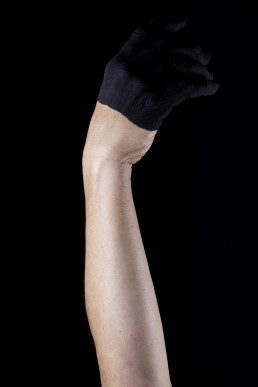“50 TONELADAS”
Carlota Lagido
A cor preto tem 50 tons reconhecíveis. Comporta uma série de apropriações simbólicas que se foram transformando e tomando diferentes significados ao longo dos tempos. É uma cor de adjetivações antagónicas.
Se por um lado o preto é a cor do protesto e do Anarquismo, é simultaneamente a cor do Fascismo. Até ao século XIX foi a cor das noivas, dado que o preto era o mais adequado para o aspeto negocial que envolvia qualquer casamento na altura. Preto é a cor associada ao mal, mas, no entanto, é a cor clerical. Na Espanha da Inquisição, as pessoas vestiam-se de preto de forma a deixarem sobressair a expressão, sendo assim possível controlar qualquer movimento facial denunciante. O preto é também a cor da morte e do fim. Na natureza, todos os elementos, nos seus processos de decomposição, se transformam numa matéria negra. É a cor dos medos noturnos. Preto é a cor utilizada para nomear a dita “matéria negra”, teórica, da Astrofísica. É a cor do vácuo. É também a cor do princípio de tudo.
Ficha técnica
Conceção e Direção artística Carlota Lagido
Interpretação Tiago Vieira, Antoine Pimentel, Carlota Lagido
Consultoria artística José Capela
Assistência e Apoio dramatúrgico Pietro Romani
Design de cena, Vídeo, Fotografia Antoine Pimentel
Sonoplastia e Música ao vivo Antoine Pimentel
Figurinos Carlota Lagido
Design de luz Nuno Patinho
Design gráfico Joana Areal/Thisislove
Produção Horta Seca
Apoio O Lugar do Meio, ArteTotal, BCN, Mala Voadora, TAGV, Companhia Olga Roriz, Festival Temps d’Images, Citac, Missom, EIRA
Agradecimentos António Amaral, André Uerba, Gonçalo Passos
Financiamento DGArtes, Governo de Portugal
“50 TONELADAS”
Carlota Lagido
The black color has 50 recognizable shades. It consists of a series of symbolic appropriations that have been transformed, assuming different meanings over time. It is a color of antagonistic adjectives.
Black is the color of protest, Anarchism and simultaneously, the color of Fascism. Until the nineteenth century it was the color of the brides, because black was the most suitable color for the business aspect involving any wedding at the time. Black is the color associated with evil, but, nonetheless, it is the clerical color. During the Spain of the Inquisition, people dressed in black in order to let the expression stand out, thus making possible to control any denouncing facial movement. Black is also the color of death and, of the end. In nature, all the elements, in their decomposition processes, turn into a black matter. It is the color of the nocturnal fears. Black is the color used to name the so-called “black matter”, theoretical, of Astrophysics. It’s the color of vacuum. It is also the color of the beginning of everything.
Credits
Concept and Artistic direction Carlota Lagido
Performers Tiago Vieira, Antoine Pimentel, Carlota Lagido
Artistic consulting José Capela
Assistance and Dramaturgical support Pietro Romani
Set design, Video and Photography Antoine Pimentel
Soundproofing and Live music Antoine Pimentel
Costumes Carlota Lagido
Light design Nuno Patinho
Graphic design Joana Areal/Thisislove
Production Horta Seca
Support O Lugar do Meio, ArteTotal, BCN, Mala Voadora, TAGV, Companhia Olga Roriz, Festival Temps d’Images, Citac, Missom, EIRA
Acknowledgements António Amaral, André Uerba, Gonçalo Passos
Financial aid DGArtes, Governo de Portugal
